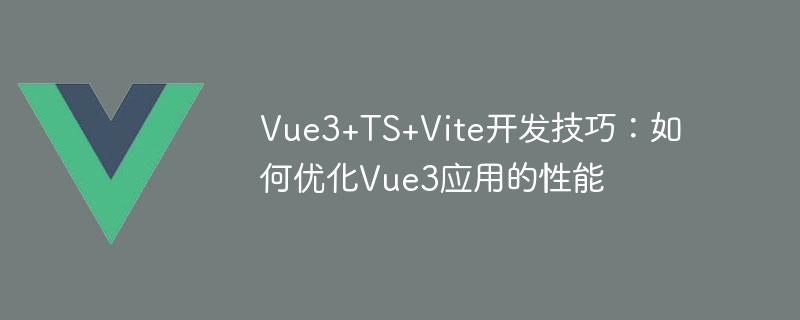所属分类:web前端开发

Vue3+TS+Vite开发技巧:如何优化Vue3应用的性能
引言:
随着 Vue3 的正式发布,学习并应用 Vue3 成为了许多开发者的焦点。Vue3 相较于 Vue2,带来了许多新特性和性能优化,如静态树提升、Proxy 响应式系统等。然而,即使有这些优化,我们在开发 Vue3 应用时仍需要注意性能问题,以提供更流畅的用户体验。本文将介绍一些优化 Vue3 应用性能的技巧,并提供相关的代码示例。
// 错误示例
const user = { name: 'Alice', age: 20 }
Object.freeze(user)
// 正确示例
import { reactive } from 'vue'
const user = reactive({ name: 'Alice', age: 20 })import { ref, computed } from 'vue'
// 计算属性示例
const user = ref({ name: 'Alice', age: 20 })
const userName = computed(() => user.value.name)
// 使用 ref 示例
const userName = ref('Alice')import { ref, watch, WatchSource } from 'vue'
// 监听一个 ref 对象
const userName = ref('Alice')
watch(userName, (newValue, oldValue) => {
console.log(newValue, oldValue)
})
// 监听一个 reactive 对象,且立即执行一次回调函数
const user = reactive({ name: 'Alice', age: 20 })
watch(() => user.name, (newValue, oldValue) => {
console.log(newValue, oldValue)
}, { immediate: true })// 异步组件示例
const AsyncComponent = defineAsyncComponent(() => import('./AsyncComponent.vue'))
// 懒加载示例
const LazyComponent = () => import('./LazyComponent.vue')<!-- Vue2 -->
<template>
<div>
<ul>
<li v-for="item in list" :key="item.id">{{ item.title }}</li>
</ul>
</div>
</template>
<!-- Vue3 -->
<template>
<div>
<ul>
<li v-for="item in list">{{ item.title }}</li>
</ul>
</div>
</template>
结语:
以上是一些优化 Vue3 应用性能的技巧,当然还有许多其他的优化方法,如使用 Memo 避免不必要的重渲染、合理使用静态节点等。在实际开发中,我们应根据具体情况选择性应用这些技巧,以提供更加高效和流畅的用户体验。希望本文能为你在 Vue3+TS+Vite 的开发过程中提供一些帮助。